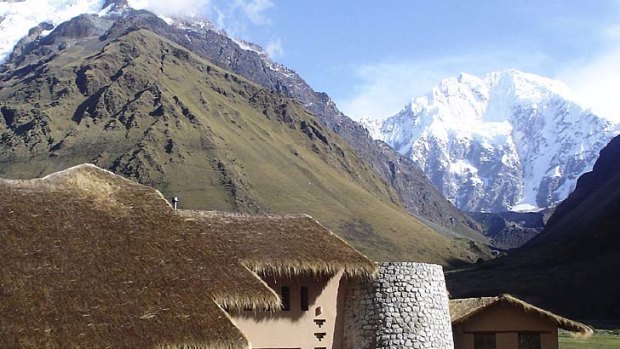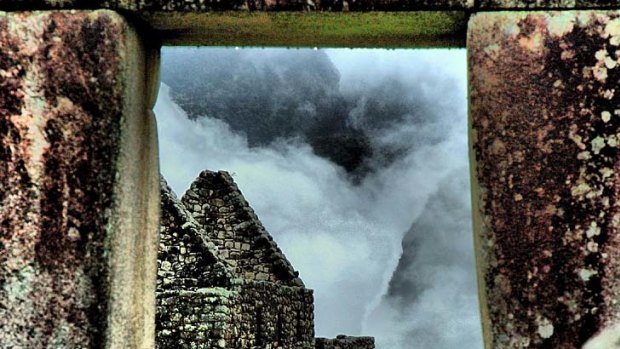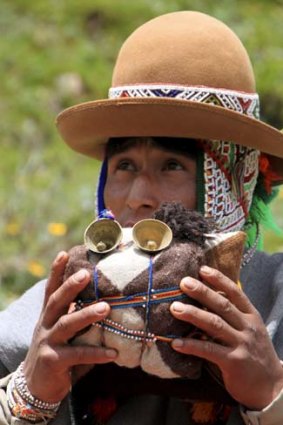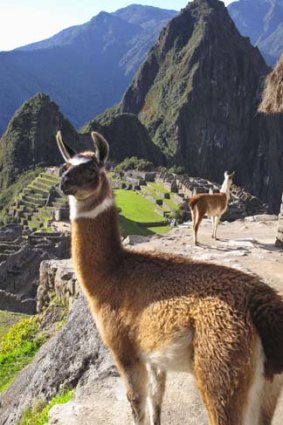This was published 11 years ago
Gods' own country
Ben Groundwater encounters wrath and luxury on an alternative path to Machu Picchu.

A lodge on the Salkantay trail.
The mountain gods are angry. Not five minutes after stepping out of a glacial pool - their glacial pool, a place we had been warned to avoid - the heavens have opened.
It's a hailstorm, little balls of ice that feel like they're being thrown with the fury of the slighted. The nearest shelter is a two-hour hike away, down a steep, muddy mountainside. There are no trees this high up, no caves around. There's nothing to do but pull a hood over your head, hunch your shoulders and ponder the wisdom of angering the keepers of these beautiful, savage hills.
It's day two of our six-day hike to Machu Picchu, the ancient Incan city and modern travellers' holy grail. This isn't our first brush with the "apus", the mountain gods, but it's certainly the most spectacular.

Atmospheric ... Machu Picchu.
Ten minutes ago it had been easy to dismiss the superstition. Gods? What gods? Victor, a local shaman moonlighting as our mountain guide, had shrugged, saying it was OK for us to swim in the glacial lake if we wanted, but the local Quechans would never dare. The apus don't like it.
A couple of us had waded into the icy waters anyway, almost instantly triggering a hailstorm, powerful and strong.
Fortunately, it stops as suddenly as it began. But the message is clear: don't mess with the apus.

A guide and shaman, Victor, makes an offering to the gods.Credit: Ben Groundwater
This entire trek, we will be at the mercy of the spirits that inhabit these mountains. The hailstorm is the gods at their worst. A few days later, a flawless morning below two soaring peaks will be the gods at their best. And there will be everything in between.
The trail we're hiking was carved by the god-fearing Incas, an ancient path to Machu Picchu. It's not the famous "Inca Trail" that pops up on most people's bucket lists but a quieter, more luxurious alternative.
(Truth is, those Incas cut more than 48,000 kilometres of paths through the Peruvian jungle, including nine kilometres leading to Machu Picchu. So it's actually not a case of "the" Inca Trail but rather "an" Inca trail.)

Llamas with the famed ruins behind them.Credit: Getty Images
We're marching along the Salkantay trail, which has several attractions to set it apart from its more famous counterpart. For starters, the crowds. There aren't any. A few horses, a couple of cows and that's it.
For those doing the "Lodge to Lodge" trek, there is also the accommodation. Most hikes through the Andes involve bedding down under a floppy canvas roof each night, your only door a zipper, your patio a patch of grass.
The Salkantay, meanwhile, is studded with the sort of luxurious lodges that almost seem too lavish for such rustic surrounds. Warm beds? Hot tea? Cold beers? Three-course meals? Hardly roughing it. It's easy, however, to get used to the idea.
Machu Picchu is amazing, and it's the reason we're all here, but there's an old cliche that it's not the destination that matters, it's the journey. There's not a moment on this trek, from the high mountain passes to the stunning vistas, the local villages, the five-star meals and the hot-tub soaks, when you doubt the truth in that.
Day one begins early, with a pick-up from Cusco, the ancient Incan capital that is now a thriving epicentre for hikers and travellers. We've got a full morning's driving to make it to the trail head high in the Andes.
This is the last time we'll see a car for a while. Or civilisation, really. Our bags are unloaded at a clearing and strapped to the backs of horses, while the hikers settle day-packs over their shoulders, adjust walking poles and prepare for the first steps of a sacred journey.
The gods are being kind today, the blue skies above streaked only by high cloud. Javier, the leader of this group of 12 gringos, leads the way up the rocky path that grips the side of the mountain like it fears for its life.
It's a gentle walk this afternoon, with only a slight uphill gradient - a good way to get used to the 3500 metres of altitude. Far off into the distance, we can already see the snow-capped Salkantay peak. It seems incredible to think that in two days' time we'll be there, standing high on a pass just below it.
Today, however, it's just a stroll through the mountains, enjoying the serenity of desertion.
This is what hiking is all about: a perfectly still day; the sound of hummingbirds; the rush of a river; the sight of condors up in the clouds; no phones, no computers, no crowds - just an open trail snaking through some of the world's most spectacular scenery.
With the sun starting to set and a chill creeping in, we round a corner and the valley opens up into a wide "pampa", a high plateau. There, in the centre, is our home for the next two nights, the Salkantay Lodge. We're greeted at the door by staff holding hot towels and mugs of tea.
"Leave your shoes outside," Javier says. "The people here will clean them." Inside, a warm shower awaits. If anything was sent by the gods, right now it feels like this.
By the time we're lacing up our boots again for day two, a bizarre obsession has taken hold of our group: altitude. "How high up are we now?" a German hiker asks Javier, who whips out his GPS.
"About 3600 metres," he says.
We march a little further. "Now how high, Javier?"
This is the furthest into the atmosphere many of us have been and it becomes all-consuming. How high now?
Today is designed for acclimatisation, with a half-day return trek to Soray, a glacial lake 4100 metres above sea level. Victor has been detailed as our guide and he skips ahead immediately, playing a flute as the rest of us heave and gasp in the thin air.
"Victor is a proper shaman," Javier whispers. "He knows things that other people don't."
At the lake, Victor makes an offering to the apus to bless our journey. He proffers a parcel of the mountain gods' favourite things: figs, wafers, quinoa, beans, a llama foetus and some animal crackers. Hey, there's no accounting for taste.
Somehow, it feels right, like we're getting the apus on our side. Then we ruin it by jumping in the lake, unleashing all that fury. They're a sensitive bunch, these apus.
Day three is feared by some, relished by others. It's the longest of all the hikes, and the highest: five hours of climbing to a pass 4600 metres above sea level, before another three-hour descent to the next lodge. The gods are over yesterday's hissy fit, gifting us with a fine day as we heft our day packs and start walking.
One foot in front of the other: that's the plan for today. Just keep the feet moving. The initial trek is a gentle climb past a tiny village before we hit the hard stuff, a cluster of 14 switchbacks up the steep mountainside. Breath comes short and rasping at this height, our only friends a sturdy walking stick and a pocket full of chocolates.
The Salkantay gets ever closer as one foot follows the other, up the switchbacks and onto another pampa, which leads up to the final climb. Now the soaring Humantay peak is visible, a clone of its opposite number, rocky and imposing.
One foot in front of the other. Breathe. One foot in front of the other. Breathe. The last step up to the pass is one of extreme satisfaction. You feel like you're standing on top of the world on that pass, despite two peaks that still tower above you.
From there, it's a comparatively quick jaunt to Wayra Lodge, where there's a wood fire, cups of mint tea and a masseuse waiting. (Oh yeah - there's a masseuse.)
There's food, too. The Lodge to Lodge trek has been nicknamed the "lunch to lunch" trek, and you soon find out why.
Anyone who plans to lose weight over six days of hardcore hiking will be sadly disappointed. Every breakfast is hot and huge; each lunch a three-course monster; the dinners events in themselves.
All meals are prepared by our chef, Luis, who travels with our procession through the deserted mountains, his produce loaded on the backs of horses and mules, which only adds to the feeling of isolation. It makes you realise you can't just call it quits and go home.
There's only one way out of here, and that's along this narrow, deserted path.
The hiking gets easier over the next few days as the scenery changes from snowy peaks to verdant forests that mark the far extremity of the Amazon.
Our altitude madness subsides, to be replaced by a new obsession: Machu Picchu.
"Where is it from here?" an American hiker asks.
"Around this valley," Javier says with a sweep of his arm. "Don't worry, you will see it tomorrow."
Finally, that big moment approaches. Today, day six of our hike, we'll climb through a "cloud forest", blanketed in fog, before popping out at Llactapata, a group of Incan ruins with a view to Machu Picchu that few ever get to see.
However, the apus are back to their old tricks. It's hard to take in stunning views from the inside of a cloud - at Llactapata all we can see is grey. "Give it time," Javier assures us, "I've never missed this."
He's right.
A few minutes later the clouds part, revealing the treasure Hiram Bingham stumbled upon all those years ago, the prize we've hiked all of these days to find: Machu Picchu.
It's spectacular, of course, an amazing sight. And it will be even more thrilling up close tomorrow. But the reason we're here, the highlight of our trip? That feels like it's behind us now, on the rocky mountain trails, in the high peak of the Salkantay, across the wide, green pampas. The home of the apus. Surely they would agree.
How to survive a six-day Andean trek
The right gear
It's worth spending money on appropriate equipment: raincoat and waterproof pants, a good day-pack with waterproof cover, solid hiking boots that have been worn in and enough layers to keep you warm at 4500 metres.
Hiking poles
These might look a little silly but you soon learn that even one pole makes a huge difference when trying to haul your carcass up a steep, narrow trail. And it's even more beneficial when trying to lower your carcass down one. Make the investment.
The pilgrim walk
"Walk like this," our guide Javier said, "and you'll be flying up the mountains." Yeah, right, you think. But it actually works. At high altitude, don't try to stride it out — just take small steps, barely putting one foot in front of the other, and you'll be conquering Andean peaks in no time.
Acclimatisation
The Lodge to Lodge trek includes a period of acclimatisation but you'll be doing yourself a huge favour to allow a couple more. Plan to arrive in Cusco three or four days before the trek begins — that way you'll have time to explore this fascinating city, plus you'll stop huffing and puffing so much.
Trip notes
Getting there
LAN Airways flies to Cusco via Santiago and Lima. 1800 558 129, lan.com.
Staying there
For pre- and post-tour stays in Cusco, the Inkaterra La Casona has luxury rooms from $US740 ($725) a night. inkaterra.com/en/cusco.
Hiking there
The Classic Safari Company offers the Lodge to Lodge trek in Peru for $2320 a person, which includes transfers from Cusco, six days of trekking, six nights' accommodation in luxury lodges, all meals, two guides, plus entry into and a guided tour of Machu Picchu. 1300 130 218, classicsafaricompany.com.au.
More information
The writer travelled as a guest of the Classic Safari Company.
Sign up for the Traveller Deals newsletter
Get exclusive travel deals delivered straight to your inbox. Sign up now.